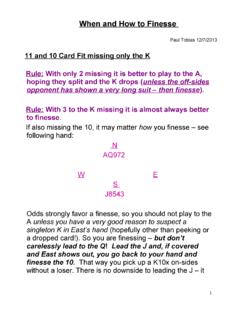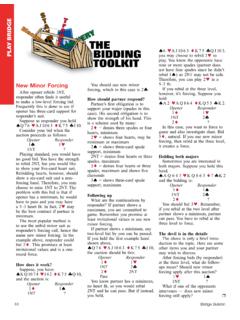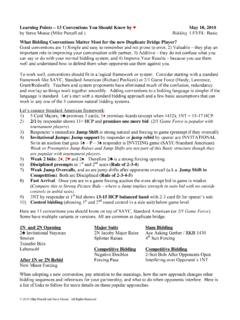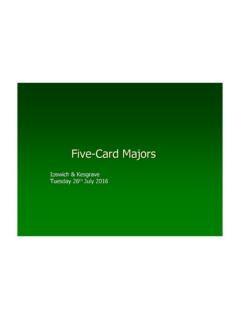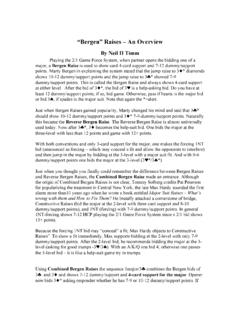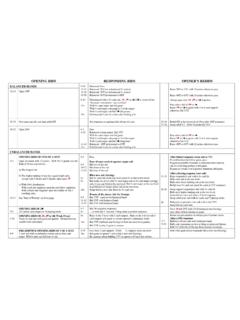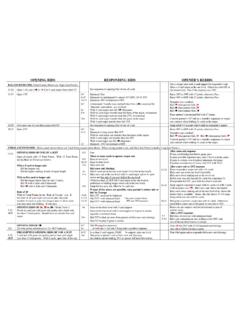Transcription of Showing Support for Partner’s Opening of 1 of a Minor
1 Showing Support for partner 's Opening of 1 of a Minor General requirements for Showing immediate Support : No 4+ card major (& generally no 4 card diamond suit after a 1S opener). S 5432 3Kx 2 KQJ1098 Cx: Bid 1S (after 12 opener). NT is not a better description (1N: 6- bad 10; 2N=good 10-bad 12-; 3N=good 12-15). NT does not deny Support for the Minor Especially for the 3N bid, you need the majors stopped (for 2N one might be partial). S Qxx 3 Kxx 2Q10xxx Cxx: Bid 1N (after 12 opener). S Axx 3 QJx 2J10xxx CKx: Bid 2N (after 12 opener). S AQx 3 QJx 2 QJxxx CKx: Bid 3N (after 12 opener). You have an 8+ card fit (or a least it's highly probable that you do). Responder can have only 4 diamonds there is no more descriptive bid and you agree that the only short . diamond by opener is exactly 4-4-3-2. S xx 3xx 2 KQJx CKJxxx: Raise diamonds (after 12 opener, playing 2/1).
2 Side note: Adjusting for hands that would open NT (or 2C then NT) at some level: You will open a 3 card diamond suit about of the time You will open a 3 card club suit about of the time Note about bidding: Any system needs to have bids to describe the available hand strengths (preemptive, constructive, invitational, game forcing, slam going) for each hand type (in this case, hand type means a hand that needs to make an immediate raise of partner 's Opening Minor ). Obviously you can't have unique bids to distinguish each of the strengths BUT. You must have bids that include each strength for each hand type At a minimum forcing and non-forcing bids Ideally, you would like to distinguish some of the ranges Sample Minor -raising hands with various strengths (after 12 opener): Preempt ( Non-vulnerable!): S x 3xxx 2 KJxxxx Cxxx Constructive: S Qxx 3xx 2 KJxxx CQxx Game Invitational: S xx 3 KJx 2K10xxx CKxx Game Forcing: S xx 3 AQx 2K10xxx CAKx Slam Invitational: S Axx 3x 2 KQJxxx CAQx Standard and the problem with it: Single Minor raise = 6- bad 10; double raise = good 10-bad 12.
3 What do you do with a game forcing hand & no other 4 card suit? You can't play in 2N could be important at match points (pair games). You can't preempt below the 4-level Page 1 of 7. Beth Tobias Inverted Minors Solution Inverted Minors: Basic Inverted Minors: Single Minor raise=good 10 infinity Forcing one round (by an unpassed hand see partnership decisions needed below). Double Minor raise=less than a game invitation Consider vulnerability with very weak hands Provides a forcing bid, allows investigation of NT and gives plenty of room for exploration with stronger hands Warning: This does not work well with short club systems (though you can use it for the diamond raises if the short club is because diamonds promise 4+ card length). Some common variations: Distinguish weak from constructive Double Minor raise is less than constructive (basically preemptive) (my choice).
4 With a constructive raise you either (choose 1 of these): Bid 1N which may be seriously off-shape Bid 2S which gives up the weak jump shift (my choice). Distinguish Invitational from game forcing or better Use the jump shift to the other Minor (1C-22 or 12-3C) to distinguish between invitational only and game force or better. This is called Criss-Cross. Can play it either way: single raise=GF+ & Criss-Cross=invitational or vice versa If Criss-Cross is invitational, you can't play 2N after a 12 Opening For 12-3C, you lose other possible uses of the 3C bid. o I use it for a natural, game invitation a hand for which there is no other bid playing 2/1. Partnership decisions needed: Are inverted minors on or off by a passed hand? Recommendation: On The single raise is specifically invitational (non-forcing). Otherwise you have most of the same problems that inverted solves Are inverted minors on or off after a double?
5 Recommendation: Off You need the single raise for a constructive raise There are several choices for responses (see options after a double below). Are inverted minors on or off after an overcall? Recommendation: Off You need the single raise for a constructive raise Game invitational or better hands can start with cue bid Page 2 of 7. Beth Tobias Inverted Minors Follow-ups to double Minor raise played as weak: Pass with anything short of a big hand With 18-19 HCP and all outside suits stopped, bid 3N. S Axx 3 Kxx 2 AKxx CAJ10 (after 12-32): Bid 3N. With 18-19 HCP and missing a major stopper, bid the major you have stopped S AKx 3xxx 2 AKxx CAJ10 (after 12-32): Bid 3S. If slam invitational, control bid or ask for keycards S AK 3A 2 Axxxxxx CKJxx (after 12-32): Ask for keycards Follow-ups to single Minor raise played as invitational or better: Much variation here mostly in strength required for bids One major difference is match point (pairs) vs IMP (teams) bias: If both 2N & 3 Minor make exactly: In pairs, you definitely want to be in 2N.
6 In teams, it makes absolutely no difference which contract you are in o In fact, there is an argument that you never want to play 2N in teams Thus, in some variations, 2N cannot be played and in some almost all rebids are game-going Since we play mostly pairs, my recommendations will be oriented to finding NT at any level. Note: The only bids that can be passed below game by either hand are 2N and 3 of your Minor Opener rebids NT if balanced with both majors stopped: 2N: minimum, does not accept game invitation SQJx 3 Axxx 2 Qxxx CKx (after 12-22): Bid 2N. Responder usually passes with invitation or raises to game with game force Responder can correct to 3 of Minor with invitation and unbalanced hand (non-forcing). S x 3 Qxx 2 Qxxxx CKQxx (after 12-22; 2N): Bid 32. If slam invitational, responder can control bid or splinter or ask for keycards 3N: accepts game invitation (14 HCP or 15 HCP with some reason didn't open 1N).
7 SQJx 3 Axxx 2 KJxx CKx (after 12-22): Bid 3N. If slam invitational, responder can control bid or ask for keycards 4N: 18-19 (and you should also have other Minor stopped at this level). S KQx 3A109x 2 KJx CAQx (after 12-22): Can bid 4N, but see note Note: This takes up a huge amount of room. You will generally do better to control bid or ask for keycards. Responder should pass with a minimum invitation. If responder thinks slam is possible, you can agree to show keycards (as if 4N were a keycard ask) to keep yourselves out of a bad slam. Page 3 of 7. Beth Tobias Inverted Minors Opener rebids 2 of a major Showing a stopper to explore for NT (& see 22 after 1C-2C below): Denies stopper in other major; does not promise extra values S AQx 3xx 2 Axxx CQ10xx (after 12-22; 2S): Bid 2S then pass 2N or 32. S AQx 3xx 2 AQxx CQ10xx (after 12-22; 2S): Bid 2S then raise 2N to 3N, but pass 32.
8 Responder with stopper in other major bids 2N with invitation only, 3N with game force S xx 3 KJx 2K10xxx CKxx (after 12-22; 2S): Bid 2N. S xx 3 AQx 2K10xxx CAKx (after 12-22; 2S): Bid 3N. o If slam invitational, responder can control bid or splinter or ask for keycards Responder without stopper in other major bids: o 3 of Minor with invitation only S KJx 3xx 2K10xxx CKxx (after 12-22; 2S): Bid 32. o Over 23, can decide with partner if 2S is a partial stopper not promising extras S J10x 3xx 2 KQxx CKJxx (after 12-22; 23): Bid 2S. o Anything else is game forcing BUT. Discuss with partner if you can stop at 4 of Minor if both have minimum Opening values. If you generally play 4 of Minor as a keycard ask (see keycard ask options below), discuss in which sequences is just a game invitation instead. o If slam invitational, responder can control bid or splinter or ask for keycards Opener's rebids with no major stopper: Without extra values: Generally rebid 3 of Minor .
9 Remember you need about 28 combined points to make a Minor game. Sxxx 3xx 2 AKxx CAJxx (after 12-22): Bid 32. After 1C-2C with diamonds double-stopped, you can try 22 and hope to hear NT from responder (if you choose my option for the meaning of 22 below). Drawbacks: o Why didn't partner bid NT in the first place with both majors stopped? Most likely, he/she is unbalanced (probably short in diamonds) and therefore has at least 6 clubs. Unless you are very balanced, you might actually do better in a club partial. (If the reason was that responder was strong, he/she will bid again over 3C). o This gives your silent opponents a cheap way to back into the auction Sxxx 3xxx CAKx CAQJx (after 1C-2C): Bid 22 and correct 2 of major to 3C. Sxx 3xx CAxx CAQJxx (after 1C-2C): Bid 3C. After 12-22 with a real club suit and a maximum based on distribution, you can try 3C to invite game (if you choose my option for the meaning of 3C below).
10 -- 3xxx 2 AKxxx CKQxxx (after 12-22): Bid 3C. With extra values: Make bids that cannot be passed. It will usually sound like you are looking for NT, but when you pull responder's NT to some other bid or keep bidding beyond 3 of your Minor , responder will get the idea that you are game-going in the Minor . Page 4 of 7. Beth Tobias Inverted Minors Opener's rebids with a slam invitational hand: Jump in new suit is a splinter S AKx 3x 2 AQxxx CKJxx (after 12-22): Bid 33. If partner now bids 4C Showing the a C control you can ask for keycards and get to a good slam opposite the right invitation (like S xxx 3 Axx 2 Kxxxx CAx). Ask for keycards S AKx 3x 2 KJxxx CAKJx (after 12-22): Ask for keycards Double jump in new suit is exclusion keycard ask (except kickback suit if you play kickback). If you have super-distributional (but not strong) hand, you can bid 5 of Minor but remember that you don't know partner 's strength and could be really making things difficult for him/her.
